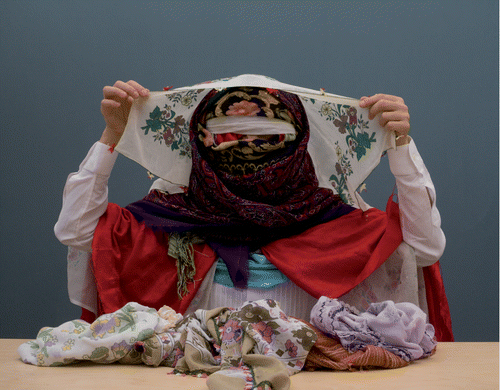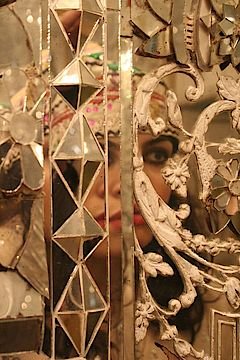The Seen and the Hidden: (Dis)Covering the Veil
The veil is one of the most symbolically charged pieces of clothing in contemporary dress. With its clear connections to faith, sexuality, and public life, it evokes elements that are both seen and hidden and invites discussion and controversy through its simultaneously engaging and defensive nature. The practice of veiling became more closely associated with Muslim women in the 19th century through its exoticization and fetishization in Orientalist paintings of masters like Ingres and Delacroix. It remains one of the most visible icons of contemporary Islam, regardless of its deep roots in the two other Abrahamic religions—Christianity and Judaism, and today provokes numerous tensions between religion, identity, and feminism. It represents an important cultural tradition, yet remains a very personal practice for Muslim women. It is this individual, yet universal nature that renders the veil an iconographic symbol in the public sphere and an increasingly popular concept within contemporary artistic practice.
Throughout the world, heated discussion surrounds the practice of veiling. In the West, the veil has often been interpreted as a symbol of backwardness and oppression, generating controversy where immigration and assimilation have caused a cultural clash. In France, for example, the headscarves of young Muslim students were deemed incompatible with the laïcité (strict secularity) of public schools, and similar conflicts have arisen in countries like Germany and Britain. However, this discordance also exists outside of Europe, even in predominantly Muslim countries such as Turkey where, for example, the rigidly secular constitution bans women who work in the public sector or attend universities from wearing headscarves. As a result, protests have come from the conservative and religious in rural areas, as well as from the growing number of urban Turkish women who choose to cover. There and elsewhere, veiling has simultaneously become a symbol of Islamic autonomy and illustrative of the significance of protection, privacy, morality, and piety.
Given the amount of controversy surrounding the veil, it is no surprise that it has become an increasingly common theme in art making, especially for artists working in the Middle East, North Africa, and South Asia, and of the Muslim Diaspora. The subject retains powerful symbolism outside of the Muslim World as well, often addressing subjects like women’s rights, domestic life, and issues surrounding the gaze. In the past twenty years, facing the radicalization of Islam in countries such as Iran, Algeria or Afghanistan, artists like Shirin Neshat, Zineb Sedira, and Mona Hatoum have emphasized the ambiguous role of the hijab in public life, and also in the private sphere of Muslim women by recalling feminist discourse and critical thinking. While influenced by these pioneers, the younger generation of post-September 11th artists deal with the veil in their own ways, bringing new perspectives to an old debate. In a globalized, yet dislocated world, the stakes are radically changing. The dialogue is no longer about fighting issues, as can be seen in the films and videos of Neshat, but rather about composing with them. The intentions of this exhibition are therefore to shed light on the complex relationship of the veil with contemporary society, to underscore individual questioning by examining diverse current artistic responses, and to present a trans-cultural exploration of various approaches to the literal and, as importantly, metaphorical meanings of the veil.
Touching on sensuality, spirituality, cultural tradition, politics, and the perception of Muslim women, the artists in this exhibition present diverse interpretations of the theme of veiling. For example, Canadian performance and video artist Fahreen HAQ, who is of South-Asian Muslim descent and considers veiling an important element of her family’s strong cultural heritage, often alludes to the practice by saturating her work with “political, sensual, and meditative qualities.” Asma Ahmed Shikoh, an artist of Pakistani heritage who wears a headscarf, uses the collected hijabs from one hundred Muslim women across the United States for her piece Beehive Project by incorporating the veils into a honeycomb-shaped sculpture. Through this empowering work, the artist combats negative stereotypes and addresses the misunderstandings surrounding these women in American society. Negar Ahkami, the American-born daughter of Iranian immigrants, appropriates the style of Russian matroyshka, or nesting dolls. in her work Persian Dolls, combating stereotypes and deconstructing the layered identities of Iranian women.
The artists Marjane Satrapi, Shadi Ghadirian, and Sara Rahbar each engage the experiences of Iranian women, who are required to cover under the law of the Islamic Republic, bringing specific significance to their work. Satrapi's critically acclaimed, graphic novel-turned-feature film Persepolis is an autobiographical journey widely read in the West. Satrapi, who left Iran for Vienna after the 1979 Revolution and now lives in France, uses humor when discussing her childhood perception of veiling. However, it becomes a metaphor for her homeland when, as a confused teenager, she symbolically places the veil on her head to return to a place that, while challenging, remains her home: Tehran. Both Shadi Ghadirian and Sara Rahbar offer a view into the current Iranian experience. Ghadirian, who works primarily in photography, interrogates the preconceived role of women under the Islamic Republic, also using humor, by playing on the private, domestic lives of Iranian women. Whether incorporating modern-day themes into imitation Ghajar-era portraits or anthropomorphizing kitchen objects into domesticated women, Ghadirian’s work draws on her personal experience as a contemporary woman in a society that challenges the expression of feminine identity. Rahbar, whose family fled for the United States at the time of the Iran-Iraq War, now lives between New York and Tehran. She creates work primarily as a means of self-discovery, the crux of which, like many artists before her, is about understanding her own diaspora: the memory of and longing for her homeland while existing between two fundamentally incongruent cultures. Her textile and photographic works often incorporate both traditional fabrics as well as nationalist and feminist symbols, featuring the artist as the sometimes masked or veiled model.
Nilbar Güres and Esin Turan, two artists of Turkish heritage who live and work in Vienna, also address the challenges of existing between cultures, where expressing a critical viewpoint while remaining an outsider produces tension. For instance, in her video Soyunma/Undressing, Güres removes a series of headscarves given to her by friends, family, and other women of personal importance, metaphorically revealing central elements of her history and cultural heritage. “The reason for my performance,” writes Güres, “is to question and discuss the situation of Muslim women living in Austria who are impacted by a racist climate in public space by experiencing discrimination in everyday life.” Although still personal, Esin Turan's work takes a significantly more provocative position by combining the imagery of the veil with a complex series of symbols, including those of terrorism and sexual freedom, to examine vast ranges of perceptions on social and political issues within the Muslim world.
French street and performance artist Princess Hijab takes a highly satirical and political stance on veiling by postering images of veiled women in the streets of Paris and tagging fashion and beauty advertisements by covering models in a hijab of black marker. Also working in France is Zoulikha Bouabdellah of Algerian descent, who makes work that explores personal relationships to identity and immigration, often utilizing the veil to explore acts of revealing and concealing.
Born in Baghdad, Ayad Alkadhi left Iraq after the first Gulf War, eventually arriving in the United States where he lives and works today. His works mix traditional Arabic calligraphic techniques with contemporary multimedia painting and collage. Like his personal experiences, Alkadhi’s art exists at the intersection of Near Eastern and Western cultures. Other non-Muslim artists also pick up on themes of cultural crossroads, though often in a more subtle way, such as Bulgarian-born, Vienna-based artist Adriana Czernin. In her work she obscures elegantly drawn female figures with delicate patterns recalling the latticework of the traditional Arabic mashrabiya, a common window covering that conceals the highly protected domestic lives of women throughout the Muslim world. Austrian Hannah Menne's new textual work, produced for this exhibition, examines the intersections of religious views on veiling as seen through sacred texts.
The veil also occasionally appears with “Eastern” inspiration outside of the contemporary Islamic context in surprising ways, even if frequently speaking to similar ideas. Cartographies of Sex, a two-part video installation by German-born, Vienna-based artist Katrina Daschner explores unveiling through the art of burlesque; this specific work was inspired by and features vintage footage from a 1940s Egyptian movie starring the famous belly dancer Naima Akef. In the hair-covered works of Viennese performance artist Marlene Haring, the “hair” acts ironically by subverting the traditional veil that is meant to hide a woman’s hair. When the hair covers a household object the work explores the humor in the act of hiding, such as with the Le Corbusier chaise-lounge that appears in this exhibition.
While not physically revealing, the veil remains provocative in its concealment. Women’s rights, relationships to social space, and religion are examples of the issues continually raised by considerations of veiling. The current global debate that is likely to extend well into the future will continue to create constructive dialog and shape global artistic practice. However ambiguous, empowering, or reactionary these artistic positions may be, their examination and presentation is a significant and necessary contributions to an evolving discussion that seeks to define one small facet of the human experience.
Role: Co-curator, with Martha Kirszenbaum & Karin Meisel
Date: May 22—August 29, 2009
Location: Austrian Cultural Forum New York, NY
Artists: Negar Ahkami (USA), Ayad Alkadhi (Iraq/USA), Zoulikha Bouabdellah (Algeria/France), Adriana Czernin (Bulgaria/Austria), Katrina Daschner (Germany/Austria), Shadi Ghadirian (Iran), Nilbar Güres (Turkey/Austria), Marlene Haring (Austria), Farheen HAQ (Canada), Princess Hijab (France), Hannah Menne (Austria), Sara Rahbar (Iran), Marjane Satrapi (France), Asma Ahmed Shikoh (Pakistan/USA), Esin Turan (Turkey/Austria)



